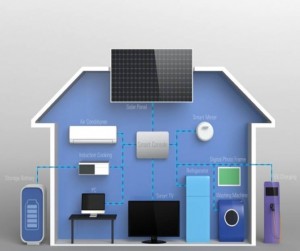 The smart home framework (SHF) is a software framework aimed to simplify and speed up the modelling of smart infrastructure (i.e., smart home, smart communities and the smart grid) in the research community. It provides basic software components (e.g., appliances, generators and storage) that can be assembled together to build general models of smart homes and communities. These components can be extended to construct specialised models to meet the specific needs of any particular project. This approach enables rapid, bottom-up modelling of smart homes and communities with resuable models and components. The SHF emphasises on reusability which we believe will eventually lead to standardised models of appliances (e.g., washing machines, ovens, fridges), smart homes and smart communities that can be made available online for all.
The smart home framework (SHF) is a software framework aimed to simplify and speed up the modelling of smart infrastructure (i.e., smart home, smart communities and the smart grid) in the research community. It provides basic software components (e.g., appliances, generators and storage) that can be assembled together to build general models of smart homes and communities. These components can be extended to construct specialised models to meet the specific needs of any particular project. This approach enables rapid, bottom-up modelling of smart homes and communities with resuable models and components. The SHF emphasises on reusability which we believe will eventually lead to standardised models of appliances (e.g., washing machines, ovens, fridges), smart homes and smart communities that can be made available online for all.
This website provides resources to help get started with the framework. In a nutshell, the framework contains the code for modelling smart homes and communities. Also, it comes with two additional toolkits for optimisation and visualisation for smart home and community data.
| 1. For a quick summary of the smart home framework and its modules and its applications, please see the following paper (2 pages) on the publication page: Muddasser Alam, Alper Alan, Alex Rogers, and Sarvapali D. Ramchurn. Poster Abstract: Towards a Smart Home Framework. In the 5th ACM Workshop On Embedded Systems For Energy-Eefficient Buildings, Rome, Italy, 13-14 November 2013. |
| 2. For a quick overview of the SHF architecture, see the page on UML diagrams that will provide you with the general idea of the framework. |
| 3. We also provide a demo that discusses the motivation and merits of the SHF, the optimisation and visualisation toolkits, and code snippets and tips on modelling with the framework. |
| 4. If you would like to get a feel for development, we have two code examples. – The first example demonstrates the key code needed to develop a model of a smart home, which is then optimised (to obtain maximum utility) using the optimisation toolkit with the results shown using the visualisation toolkit. – The second example demonstrates developing a model of a smart community by creating multiple smart homes. This community is then optimised via the optimisation toolkit (to reduce the use of overall energy storage) by exchange of energy between homes. The results are shown using the visualisation toolkit |
| 5. If you would like to use the SHF, you can download the code here. The code contains the framework as well as complete code for the above examples. |
| 6. If you would like to get in contact, please feel free to contact us here. |